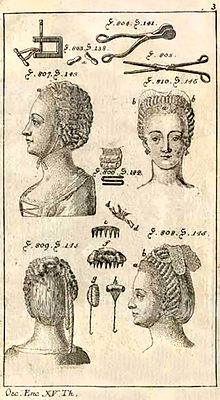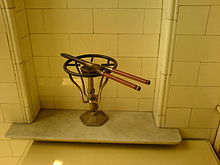Curling iron
The curling iron or furnace tongs (also Brenneisen , toupee iron or wig iron called) is a tool for undulation of the human major hair. It is no longer used in hairdressing technology .
history
The curling iron is a further development of the principle of the hairdressing method with the calamistrum . In 1872 the curling iron was developed by the French hairdresser Marcel Grateau , a memorial was erected for him in his hometown Lagnicourt and in England a curling iron was named after his first name (Marcel Curling Iron). In 1906 Simon Monroe patented a device with 7 metal teeth and in 1909 Isaac K. Shero applied for a patent for a branding iron with two flat metal surfaces. The curling iron technique was always fashion-dependent and was used by wig makers , hairdressers and in private households. The production of curls with this instrument lasted until after the Second World War, before it found its replacement in the electrically operated curling iron and the curlers finally established themselves in private hairstyling .
principle

The curling tongs work on the principle of scissors , but they are not used to cut, but only to be clamped . Instead of the cutting surfaces, two round tubes about 20 cm long are attached. Depending on the desired curl size, the diameter of the tubes ranges from 1 to 3 cm. The curling iron was heated on the stove or over the fire. Then you clamped the tip of a strand of hair between the two tubes and twisted the hair with it. In this way, one worked on several or all of the hair strands as desired. However, if you got too close to the scalp with the hot iron, there was a risk of burns. The Economic Encyclopedia by Johann Georg Krünitz writes:
- [...] the beak = iron, toupee = iron, or the toupee = pliers looks like elongated scissors, which instead of the two blades or arms have as many iron rods, one of which is round and the other hollow that the other fits into this. This iron must close well, especially at the point, or the rounded arm must lie equally in the groove of the other everywhere. One prefers the one whose riveting cannot be seen.
Hair curled with curling iron usually lasts until the next wash. The Krünitz Lexicon warns against too frequent use of this type of undulation with the words:
- If, however, the hair is burned too often, it gradually loses all its elasticity, it becomes powerless, its luster and roundness disappear, it breaks before time, and the head becomes so thin that you get instead of your own hair to put on a wig.
See also
Web links
Individual evidence
- ↑ Hans W. Kern: The techniques of hair work. Reinhard Welz Vermittler Verlag, Mannheim 2004, p. 215, ISBN 978393780550-4
- ^ Lagnicourt-Marcel: Son histoire n'est pas tirée par les cheveux. ( Memento from February 4, 2010 in the Internet Archive )
- ↑ http://www.style-hair-magazine.com/curling-iron.html
- ↑ Hair straightener with patent number 819444
- ↑ Patent number of the Hair Straightener
